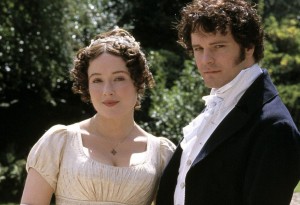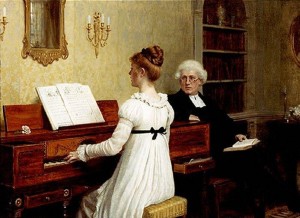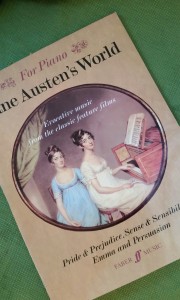Do you love films based on Jane Austen’s work or life, well, then you’ll love our theme this month. Grab your popcorn and a soda! It’s time for Movies in May!
Music and Jane Austen go together like…well, a poverty stricken but lovely young lady and a wealthy and handsome young man in search of a bride (even if he doesn’t know it yet)…
Jane Austen’s continued popularity almost 200 years after her death is a testament to the universal themes found in her books, which are as relevant today as they were in Regency England. One of the devices she uses to round out and illustrate her characters is music, but as is typical for our Jane, she does not tell us what songs, or what composers her characters favor, but leaves us to our imaginations to decide what is played. Enter the movie industry!
Austen’s works have been popular since their publication, but I believe that one of the reasons they are so immensely popular in the past 25 years is because the movie industry has made the characters so much more real to modern audiences. It is no longer necessary to guess what a well-dressed gentleman would look like in the stories or what a Regency ball gown looks like, and the most recent films (the past 25 years) have made great efforts to not only have the costumes reflect the the personalities of the characters and their place in society, but to also be correct for the era being filmed. Movie-goers and readers have become much more demanding of historically correct appearance, attitudes and even music in their entertainment and a jarring detail may bump the audience out of the world of the story when they should be immersed in it.
In Pride and Prejudice, Caroline Bingley praises the musical prowess of Mr. Darcy’s sister in order to emphasize the lack of ability of the Bennet sisters, who had a haphazard education at best. Their disparagement of Elizabeth Bennet’s singing and playing skill, however, does not prevent Mr. Darcy from enjoying her natural and unaffected performance, in contrast to her sister Mary’s weak voice and conceited air while playing. When they meet again in Kent, Elizabeth’s playing and singing for Colonel Fitzwilliam draw Darcy inexorably to her side and he is entranced, against his will, by her and her playful nature.

Jennifer Ehle and Colin Firth in Andrew Davies’ Pride and Prejudice, 1995
The 1995 BBC/A&E collaboration to film Pride and Prejudice for a mini-series developed by Andrew Davies improved on the previous film versions with its color, cinematography, and costuming. The “Making of Pride and Prejudice” book is an interesting read for avid fans as it goes through how each part of the film was approached. One area they didn’t cover, however, was music. The original score was written by and works very well with the characters. Who can forget Lady Catherine’s ominous theme as Elizabeth meets her at Rosing Park and when the opinionated lady appears without warning at Longbourn to chastise Elizabeth about the rumors of her impending marriage to her nephew, Mr. Darcy!!
In addition to the musical score by Carl Davis, which beautifully underlines the story and the characters of the story, there are three pieces of brief but significant Baroque music inserted into the story to help flesh out the characters. Early in the film, we hear Mary Bennet practicing Beethoven’s Six Variations from the opera La Molinara. We first hear her playing the simple base melody and later stumbling over the second variation with an awkward and irregular tempo which illustrates her determination to become “accomplished,” with a great deal of practice, but little talent, which became an embarrassment to her family later.
One of my favorite scenes in the film is when music is used to brilliant effect at the Netherfield ball, when Darcy and Elizabeth dance for the first time. She has sworn that she will never dance with Mr. Darcy even if he asked her, which she considered unlikely in the extreme, but courtesy demands that she accept him when that moment actually arrives. The music for their dance starts with the rather ominous introduction and with grim expressions on Darcy and Elizabeth’s faces as they rigidly start the dance in perfect formation. The dance tune then softens and continues as the cameras zoom closer and they finally start to converse during the dance. The highly stylized English Country Dance is contrasted with Elizabeth’s pert comments when she finally decides that it would be much more amusing to annoy Mr. Darcy by forcing him to talk than it would be to go through the entire dance silently. Unfortunately, the name of this lovely dance piece is Mr. Beveridge’s Maggot…yeah, I know.
Also at the Netherfield Ball, Mary Bennet forces her way to the pianoforte (the only way she can get attention) when Bingley suggests that some of the ladies play during supper and she plays and sings a morbid (to our modern sensibilities!) song set to Handel’s Largo, “Slumber, Dear Maid”. Her off key, affected singing makes her more sensible sisters cringe as everyone at the ball laughs and stares at the only plain, and most ridiculous Bennet girl. To make matters worse, Mr. Bennet interrupts Mary as she plunges into a second song, telling her to “Let the other young ladies have time to exhibit.” Mary’s shrill tone while singing is accented with the howling of the dogs and whinnying of the horses outside Netherfield as she sings. When Mary leaves the instrument in embarrassment, Bingley’s sister, Mrs. Hurst, promptly sits down and plays Mozart’s Rondo alla Turca very quickly and competently, and looks up with a smirk at the Bennets when she finishes to make sure they recognize her superiority.
This one-up-(wo)man-ship between the Bingley sisters and the Bennet sisters illustrate an important point between the two families. The Bingleys are now gentry, but their grandfather was a tradesman who earned a great deal of money, which has allowed his grandchildren to go to the finest school and to have all the accoutrements of the gentry. Because of their background in trade, however, they are clutching at the hem of the true gentry and their lack of background makes them want to be more gentrified than those who has been gentry for generations, so that they can climb the social ladder. They try to separate themselves as much as they can from their antecedents and even mock Sir William Lucas for “having a very good sort of shop.” If things go well for the Bingley sisters, their children will be high enough and far enough away from the shop to sit comfortably there.

The Piano Lesson by Edmund Blair Leighton
On the other hand, the Bennets are actually in the gentry because of Mr. Bennet’s background, but are teetering towards a downward fall. His family has generations of country gentry, as well as being prosperous enough landholders to make it unnecessary that they work (the definition of gentry, although ministers and officers, the haven of younger sons, are exempt from this rule). Mrs. Bennet comes from the tradesman class and a woman’s class is determined when she marries by that of her husband. If Mrs. Bennet had been quiet, dignified, and refined like Mrs. Gardiner there would have been no question about the family’s status in society. In addition to Mrs. Bennet’s defects, their close association with her sister, Mrs. Philips, who was as low class in her behavior as her sister (if not as hysterical and hypochondriacal). Mr. Philips, a solicitor, does not have the cachet of a barrister or a judge.
The Lucas’s are also on the fringe of society. Sir William was a tolerably well-to-do tradesman who won a knighthood via “an address to the king” when he was mayor of Meryton. This elevation gave him “a disgust to his business” and he settled at Lucas Lodge to enjoy his elevated rank. Sir William is friendly and courteous, but very foolish. His family behaves reasonably well for their place in society, but the knighthood will die with Sir William and his family will inevitably sink in consequence, unless his daughters can marry up, which is unlikely as they are good-hearted, but plain.
Mary Bennet’s musical skills are again contrasted with Elizabeth later in the film, when Elizabeth plays the pianoforte for Colonel Fitzwilliam. She plays Mozart’s Sonata in A Major, not much better than Mary played Beethoven early in the film, but Elizabeth’s unaffected playing and lack of arrogance (such as that of Lady Catherine when she talks about how superior her playing would be, if she had ever learnt) give both Darcy and the Colonel a pleasant evening though not playing “half so well” as her sister Mary had at Lucas Lodge.
Footnotes:
- If you would like to play some of Carl Davis’ score from Pride and Prejudice you may buy the piano music from this, as well as some from Sense and Sensibility (by Patrick Doyle), Emma (by Rachel Portman), and Persuasion (by Jeremy Sams) in the music book, Jane Austen’s World. This book includes the beautiful “My Father’s Favourite” from Emma Thompson’s Sense and Sensibility, but that’s another story!
2. One last word: The instruments used in the orchestra at the Netherfield ball were all period-style instruments. The violins have no chin or shoulder rests, and the bows are longer than what is used now requiring. If any of you have ever tried to play the violin or viola without a chin and shoulder rest, you will know that they must all have serious neck problems after an evening of play!!

15 comments
Skip to comment form
This mini-series, borrowed on VHS from my cousin several years ago, was my first exposure to Jane Austen. I have since become what I would call a die hard fan. I watch for her influence in both books and movies. She was a great talent.
I have always wondered about the music in these movies, which songs were original and which were actual period pieces. I will look for this piano music. I have the music for the 2005 P&P but with skill like Elizabeth’s I just plunk at it. Thanks for all the research.
Thanks for sharing. I had wondered what the pianoforte pieces were that were used in the 1995 movie.
I love the country dance at the Netherfield ball and have wondered what it was for years! I was finally able to find it (including piano music and string quartet). I play both the violin and piano (not to the level of an “accomplishment” I fear, but I can play a tune for friends- hopefully without an affected manner and conceited appearance!!
The title (” Mr. Beveridge’s Maggot) was a GREAT disappointment!
sometimes I put on the 1995 P&P video primarily for the music, it’s so good.
I too ‘found’ Jane Austen based on the 1995 P&P series and haven’t looked back since! I watch it at least once year. Thank you for this insightful piece on the music. I was familiar with some of the pieces as my husband is a huge aficionado of classical music and we regularly have our music playing. The only claim to music I have, other than the enjoyment of listening, was playing the clarinet and saxophone when I was grade school/jr. high and singing in our grade school musical.
I can’t wait for this month! P&P in 3 variations are my go to movies all the time. My husband can not comprehend how I can watch them over and over.
Thank you for the music lesson today.
My husband doesn’t “get it” either!! Fortunately we have two TVs and DVD players. We come together on Dr. Who, though!! 😀
what are some of the other pieces of music played in pride and prejudice,i know one is schberts 5th symphony which i have,and there is another piece i have by beethoven and mozarts turkish march,i do have 15 copies of the 6 volume vhs i am a collector and watch them all,including 6 dvds of the 1995 version,the only version i have not located is the one from the late 60s on masterpiece theater,if anyone can name other pieces from the moie please let me know,lizzy sings the marriage of figaro opera piece voi sapete thanks sharon
i am a big fan of jane austen and have all her film and tv ersions but i am looking for the music to northanger abbey with peter firth from the 80s, i have many versions of all jane austen movies and thousands of classical music if someone is looking for a certain piece let me know i also have 5 cds from the music soundtrack of the pand p 1995 version sharon
Wonderful post, Carey!!
And I loved so many of the musical tidbits you shared, too — there were several I hadn’t known before 😉 . Many thanks! xo
I love all of the music that was either composed or chosen for P&P 1995. So much so that I have the opening theme as a ringtone on my mobile phone. I also have the Doctor Who theme, but that’s another story!
There may not be a section on Music in The Making Of book, but there is one about the dancing. That was where I first came across the title of the piece for Darcy and Elizabeth’s dance at the Netherfield Ball. I did smile when I saw “Mr. Beveridge’s Maggot” on the printed page. From what I remember it saying, a Maggot is a type of dance in this case rather than a squiggly, squirmy insect lava. That piece was also used in one of the dancing scenes in Gwyneth Paltrow’s Emma from around the same time but I seem to remember that it was played a little more upbeat and lively.
Thanks for sharing such fascinating info with us. I’m very much looking forward to reading more about some of the other dramatisations of Jane Austen’s works.
Yes, as said above I “discovered” P&P with the 1995 movie and fell in love with all things Jane. I do have a CD of the music from the 2005 movie but never came across one for the 1995 movie. I have no musical training but can appreciate music even in the background as I read.
I love listening to the soundtrack for this film. 🙂